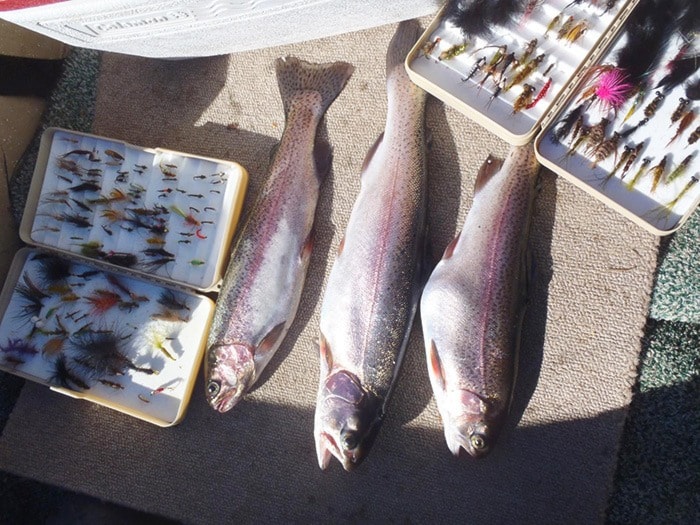Thursday, Oct. 1 was one of those beautiful fall days we have been enjoying for the past few days and the work assignment of going fishing made it special.
Imagine, all you hard-working folks – this old man goes home to Elaine and says “I have to go to work today – down on Spider Lake to see if the fish are biting.” Elaine packs me a delicious lunch, I load my boat in the truck and dutifully drive off to fly fish on Spider Lake. Now that is the kind of work to enjoy.
When I go fly fishing the only time that is moderately important is the solunar periods if they happen to be during the day, otherwise time is an element that passes too quickly. On Thursday there was a minor solunar period at about 9 a.m. and a major period starting around 3 p.m.
This information suggested to me that the fish may feed during the late morning and into the afternoon and evening. The bass fishing had been good during the week, but the trout seemed to be on a diet from fishing reports of friends.
My punt is somewhat like a golf cart in that I carry four rods: two set up with sinking lines, one with a sink tip and one with a dry line and a long leader of at least 15 feet. This allows me to fish in deep water or near the surface by simply picking up the appropriate rod and start casting.
It is hard to express the beauty of this challenging little lake. Today it was shared by large flocks of noisy Canada geese, chattering kingfishers, quiet fishing platoons of mergansers, numerous flocks of ducks, one loon, a great blue heron and three boats with fishers trying to convince the fish to bite their offerings.
The water was calm, a cloudless sky with the odd breeze rippling the surface. There was just a slight mist along the eastern shore that gave the slowly walking great blue heron a ballet rhythm that was one of the most enchanting scenes I have ever witnessed in the outdoors.
My starting patterns were a blood leech on one line and a dark green sedge pupae on the other. About 11 a.m. I hooked and lost two trout in quick succession. Then netted a nice one meal trout taken on the sedge pupae - changed the leech pattern to a dragon fly nymph, anchored and cast with a wet line over a favourite hole. I released two small bass and netted a 12-inch trout that had a distended stomach that made it look quite pregnant. The trout were put on ice as circles of rising fish lured me into deeper water. Changed the nymph pattern to Bob Hammerly's red leech. Northwest Bay looked tempting, but a slow mooch through the deep part produced nothing. Back on the main body of the lake the leech suddenly connected with a healthy fish. A few minutes later I netted a prime 15-inch trout. The accompanying picture shows my catch prior to gutting them.
In examining the stomachs they were virtually empty except the one with the swollen stomach. I was amazed at the two large plastic-foam bass lures I removed from the stomach of the trout. How it swallowed those oversized lures and still had an appetite to take my fly pattern is hard to imagine.
Next week I plan to run photos of the trout and lures I removed. If you have been putting off lake fishing, I suggest it will improve for the next couple of months. Chum salmon are showing up at Browns Bay, but reports indicate catches are modest.
Ralph Shaw is a master fly fisherman who was awarded the Order of
